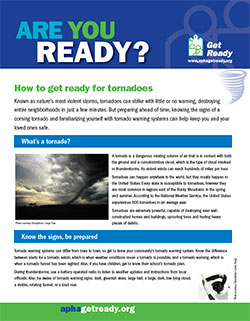Download as PDF
Known as nature’s most violent storms, tornadoes can strike with little or no warning, destroying entire neighborhoods in just a few minutes. But preparing ahead of time, knowing the signs of a coming tornado and familiarizing yourself with tornado warning systems can help keep you and your loved ones safe.
 What's a tornado?
What's a tornado?
A tornado is a dangerous rotating column of air that is in contact with both the ground and a cumulonimbus cloud, which is the type of cloud involved in thunderstorms. Its violent winds can reach hundreds of miles per hour.
Tornadoes can happen anywhere in the world, but they mostly happen in the United States. Every state is susceptible to tornadoes, however they are most common in regions east of the Rocky Mountains in the spring and summer. According to the National Weather Service, the United States experiences 800 tornadoes in an average year.
Tornadoes are extremely powerful, capable of destroying even well-constructed homes and buildings, uprooting trees and hurling heavy pieces of debris.
Know the signs, be prepared
Tornado warning systems can differ from town to town, so get to know your community’s tornado warning system. Know the difference between alerts for a tornado watch, which is when weather conditions mean a tornado is possible, and a tornado warning, which is when a tornado funnel has been sighted. Also, if you have children, get to know their school’s tornado plan.
During thunderstorms, use a battery-operated radio to listen to weather updates and instructions from local officials. Also, be aware of tornado warning signs: dark, greenish skies; large hail; a large, dark, low-lying cloud; a visible, rotating funnel; or a loud roar.
To prepare your household, pick a room where household members as well as pets can stay safe. Ideally, the room should be in a basement or underground shelter. If that’s not available, pick a room in the interior of the house with no windows. Create a household tornado drill and make sure everyone knows what to do. And don’t forget to practice your drill. Put together an emergency stockpile kit and store it somewhere you can best access it during an emergency.
In preparing for tornadoes, secure large appliances, such as the water heater, as well as large, top-heavy pieces of furniture. Mark where utility switches are located so that they can be turned off if you have enough time. Consider storing important documents or copies of documents in a fire and waterproof safe.
If you’ll need help during an emergency, ask someone nearby if she or he will assist you. Think about giving that person a spare key to your home in case of such emergencies.
During a tornado
If you’re in a building, such as your house, workplace or school, when a tornado occurs, go as quickly as possible to the pre-designated shelter area. Remember to stay away from windows. Mobile homes are not safe in a tornado. If you know where a safe shelter is, leave the mobile home immediately or seek safety on the lowest floor of a nearby building. If you’re caught outdoors, immediately walk to a nearby building. It that’s not possible, get in your vehicle, fasten your seat belt and drive to the nearest shelter. If you see flying debris while driving, pull over and park. As a last resort, stay in your car with the seat belt fastened and lower your head below window level. If you’re outdoors without a car or a nearby building, lie flat in a ditch or low-lying of land. Do not hide under a bridge or overpass.
After a tornado
When the tornado has passed, check yourself and your household members for injuries. If someone is seriously injured, do not attempt to move her or him unless they are in immediate danger. Watch out for broken debris, fallen electrical wires and damaged gas lines. If you smell gas, get everyone out of the building. Do not try to enter damaged buildings. If you can, clean up any flammable liquids that have spilled. And don’t forget one of the best ways to protect your health after a disaster: Wash or sanitize your hands as often as possible.